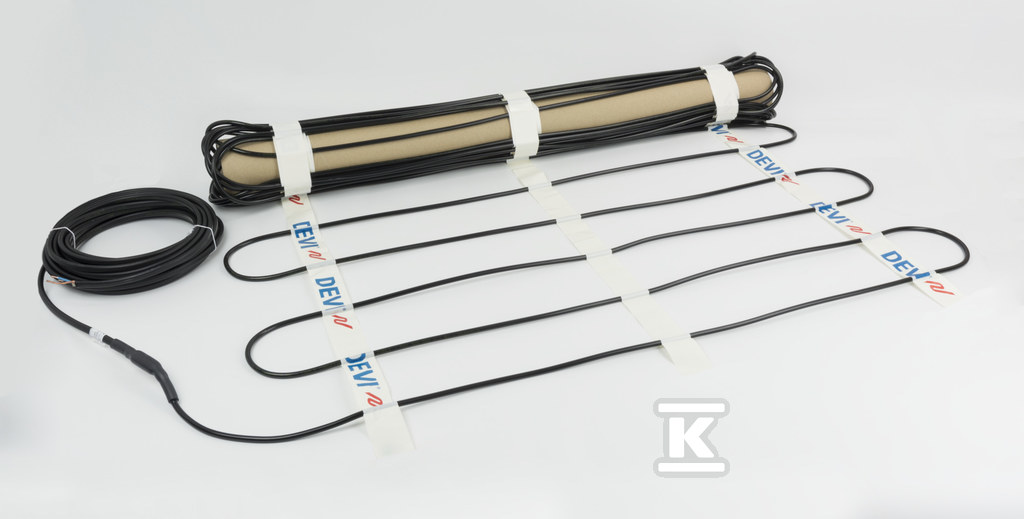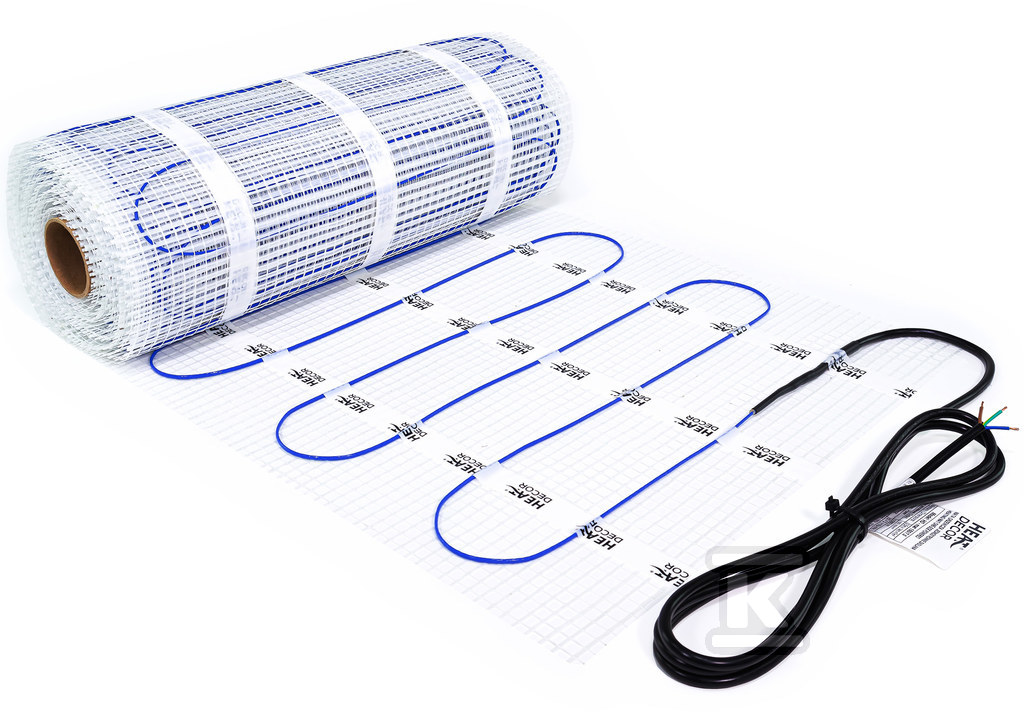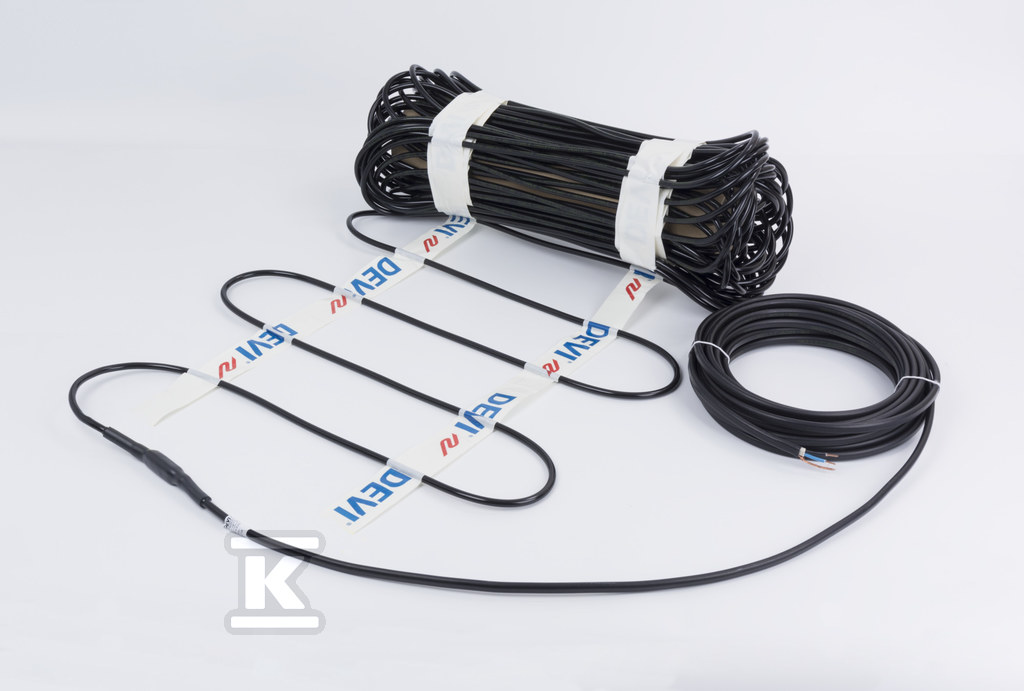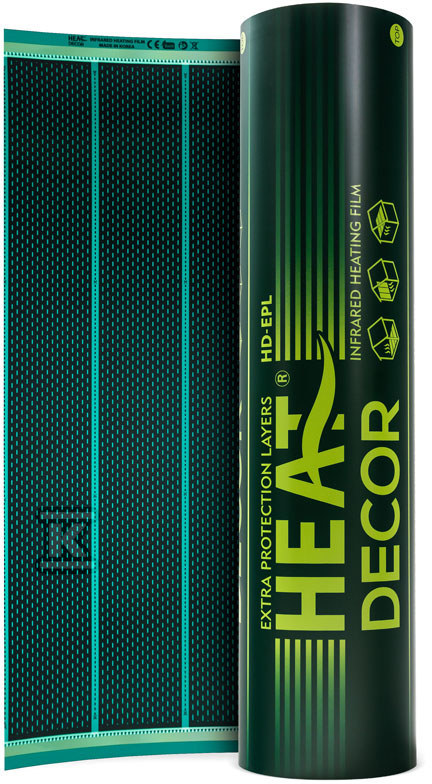Underfloor heating in the bathroom has been an increasingly popular choice in Polish homes and apartments for many years. It provides a sense of comfort, convenience and, above all, pleasant warmth underfoot. Underfloor heating makes your bathroom your private place of solace, a SPA in home conditions. You can feel blissful and exceptional without leaving your home or apartment.

Check out the heating foils at the Onninen wholesaler
What types of electric floor heating are there?
Heating mat – is one of the types of underfloor heating. Tungsten electric wires are embedded on a self-adhesive mesh made of fiberglass. It is thanks to the energy flowing through them that the wires heat up, thereby releasing heat in the room. A good choice that meets the requirements of even demanding customers is the DEVI snow 300T 613W 230V 0.5x4m 2m 83902031 heating mat or the Heat Decor HD-mat 150 W/m2 heating mat - width 50 cm - 1.5 m2 HD-MAT150/1.5 .
 Heating mats work very well in the bathroom and kitchen, but before installing it, remember that it cannot be installed under permanent objects, but only on the floor, where there is no bathtub or shower, for example. Floor heating with a heating mat is therefore a good source of heat, which can be covered with both tiles and panels.
Heating mats work very well in the bathroom and kitchen, but before installing it, remember that it cannot be installed under permanent objects, but only on the floor, where there is no bathtub or shower, for example. Floor heating with a heating mat is therefore a good source of heat, which can be covered with both tiles and panels.
Another popular type of floor heating is a heating foil . A heating foil, similarly to a heating mat, cannot be installed under permanent construction, i.e. under all devices standing directly on the surface, e.g. built-in wardrobes. The foil can be used under tiles, but floor panels or boards will also work well with it. An example of a good choice is: Heat Decor HD-EPL 60 W/m2 heating foil - width 50 cm - 1 mb EPL30 .
How does heating foil work?
The heating film is a thin heater that works on infrared. The heating film uses the conductive properties of graphite to generate heat. The film consists of an electric heater with a heater containing graphite. The heater, under the influence of electrical resistance, generates heat in the form of long infrared waves. Thanks to the heat generated in this way, objects that are in direct contact with the film or those that are within its radiation range are heated. To power both the mat and the film, you need electricity.
The heating film is available in rolls of various widths, making it easy to install and adapt to different surfaces. Because it is supplied in rolls, it can be easily cut to the appropriate size and shape of the room, providing flexibility in installation and effective coverage of the heated surface.
Where can I install the heating mat and foil?
As you already know, neither the mat nor the heating foil can be installed under built-up surfaces. These are basically the only, but very important conditions for the installation of both forms of floor heating, because they ensure the safety of you and your devices.
 The installation of the heating mat mesh does not require the use of special screeds or other building materials. The heating mats are installed on a thin-layer self-leveling screed or using flexible glue. Although heating mats are the most commonly used type of heating under tiles, you can also safely place them under panels. Remember, however, to use the so-called dampening foam. It is not recommended to place heating mats on wooden floors, because the mats can heat up to too high a temperature, causing damage to the wood.
The installation of the heating mat mesh does not require the use of special screeds or other building materials. The heating mats are installed on a thin-layer self-leveling screed or using flexible glue. Although heating mats are the most commonly used type of heating under tiles, you can also safely place them under panels. Remember, however, to use the so-called dampening foam. It is not recommended to place heating mats on wooden floors, because the mats can heat up to too high a temperature, causing damage to the wood.
However, you can install the heating foil on panels, which will work well not only in single-family homes, but also in offices. The underfloor heating system with heating foils is great for under tiles. Unlike the mat, the foil can be safely installed under boards.
Heating foil is not only floor heating , but there is also a method in which surface heating is installed. Then the heating foil can also be installed on the walls, replacing traditional radiators. However, during their maintenance, it is not necessary to bleed air, as in the case of wall radiators. The option of installing the foil on the ceiling is also possible. Ceiling foil will work well in rooms with suspended ceilings.
Both types do not require special rooms, including a boiler room. If you decide to install them, you also do not have to install a furnace. You also no longer have to worry about fuel shortages and additional costs associated with it, or frequent basement cleaning. Both mats and foils ensure cleanliness and comfort in your home every day.
Check out the heating mats at the Onninen wholesaler
Electricity consumption of the heating mat and heating foil
The power consumption of the heating mat and heating foil depends largely on the size of your rooms in which you have chosen these heating solutions, their power and the frequency of their use.
It is commonly believed that a heating mat is one of the more expensive choices when installing heating in a building. However, this depends on the insulation of the house or apartment. If the building is properly insulated, then the mat will not use as much energy as it does in the case of uninsulated surfaces.
 However, the installation of the mat itself is a relatively cheap investment, compared to other heating system solutions. The price of current operating fees, including its maintenance and efficiency, depends on your consumption and current electricity prices. The average electricity consumption of heating mats is 50-160 W per 1 m 2 of floor.
However, the installation of the mat itself is a relatively cheap investment, compared to other heating system solutions. The price of current operating fees, including its maintenance and efficiency, depends on your consumption and current electricity prices. The average electricity consumption of heating mats is 50-160 W per 1 m 2 of floor.
The heating foil allows for the consumption of less electricity than the heating mat, because on average it is 100-150 W per 1 m 2 . This is primarily due to the lower heating power. The heating power of mats installed in bathrooms is on average 150-160 W/m 2 , and the heating foil 60-80 W/m 2 .
Remember also that both forms of underfloor heating work well with renewable energy sources, including photovoltaic systems. Photovoltaics provide energy from renewable energy sources. Solar panels mounted on roofs or on the ground use sunlight, which they convert into electricity. This is an energy-saving system that takes care of the environment and reduces the costs of electricity. Specialists will help you install a photovoltaic system, who will select the right place and the power needed for your use of the system.
What is the difference between heating with a heating mat and heating foil?
- The main difference is that the mat is thicker than the foil and raises the floor level by a few millimeters. On the other hand, the foil, being an exceptionally thin material, raises the floor height by only 1 mm.
- The heating mat provides a fairly even heat distribution, but works on the principle of electrical resistance. The heating film emits far infrared waves, thus ensuring even heat distribution over the entire surface.
- Compared to other methods, a heating mat may be a cheaper way to heat a building, but in the case of foil, the savings may be even greater because it uses less electricity.
Investing in electric floor heating in the bathroom: is it worth it?
It is definitely worth investing in electric floor heating. There are several reasons for this:
-
 comfort – in the bathroom, where we often walk barefoot, it is extremely important. A warm floor is pleasant to the touch and distributes heat evenly throughout the room ;
comfort – in the bathroom, where we often walk barefoot, it is extremely important. A warm floor is pleasant to the touch and distributes heat evenly throughout the room ; - ease of installation – these are cheap and easy to install methods that any professional can easily handle. At the same time, it is a fairly clean way to modernize your bathroom;
- maintenance-free – electric floor heating does not require maintenance or service, which is a great advantage in everyday use;
- space saving – unlike traditional radiators, underfloor heating takes up virtually no space, including on the walls. This is especially important if you have a small bathroom;
- operating costs – bathrooms are usually a small space, where energy consumption is also low, and therefore operating costs will also be lower;
- long service life – manufacturers offer up to 25 years of warranty;
- Thermostat – electric floor heating requires the installation of a thermostat that controls the temperature in the room, ensuring you have the perfect temperature every time you visit the toilet.
It is worth remembering, however, that the final profitability of the investment depends on your individual living conditions, such as the size of the bathroom, the level of insulation of the building, electricity prices and individual preferences regarding your own thermal comfort. Before making a decision, conduct a thorough cost-benefit analysis, taking into account both installation costs and expected operating costs, based on your needs and budget.
What is a better choice: a mat or a heating foil?
It all depends on your individual preferences. However, there are some things you need to consider.
- Floor type – for ceramic tiles, stoneware or stone, a heating mat will be better as it provides a higher surface temperature and faster heating.
- Room shape – if you have a room with a non-standard shape, a better choice will be a heating foil, which is more flexible and adapts more easily to different shapes.
- System Thickness – As you already know, the mat is a thicker material.
- Energy efficiency – heating foil can be more energy efficient due to its even heat distribution.
- Speed of heating – the mat heats up faster, ensuring faster thermal comfort in the room.
Heating foils, emitting far infrared waves, provide heat over the entire floor surface. They are more flexible and can be easily adapted to different room shapes. Electricity consumption in the case of heating foils is lower compared to mats, which makes them more energy efficient. Heating foils can be used under different types of floors, such as ceramic tiles, panels and boards.
 Both heating mats and heating films require electricity and work well with renewable energy sources such as photovoltaic systems. Storage heating is another option that may be considered in some cases. It is important to match the type of underfloor heating to your needs and conditions, remembering that the heating mat works on the principle of electrical resistance, while the heating film emits far infrared waves to provide even heat.
Both heating mats and heating films require electricity and work well with renewable energy sources such as photovoltaic systems. Storage heating is another option that may be considered in some cases. It is important to match the type of underfloor heating to your needs and conditions, remembering that the heating mat works on the principle of electrical resistance, while the heating film emits far infrared waves to provide even heat.
The final choice between a heating mat and a heating foil depends on the user's preferences, the type of floor and the specifics of the room. Underfloor heating in the bathroom, especially under ceramic tiles, provides comfort and warmth every day, while being a practical and effective solution.
Remember how a heating mat works - on the principle of electrical resistance, while the heating foil emits far infrared waves to provide even heat.
The final choice between a heating mat and a heating foil depends on the user's preferences, the type of floor and the specifics of the room. Underfloor heating in the bathroom, especially under ceramic tiles, provides comfort and warmth every day, while being a practical and effective solution. It is also worth remembering that the standard power of the heating mat allows for quick achievement of a comfortable temperature, while minimizing the risk of fire in the heating system. Regardless of the choice, both systems offer a significant improvement in thermal comfort in rooms finished with ceramic tiles.
But remember, no matter what you choose, both options are a good way to save money, enjoy comfort and convenience every day in the long run.